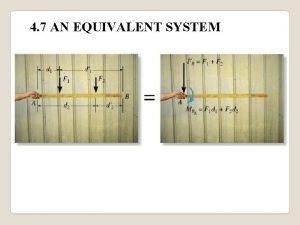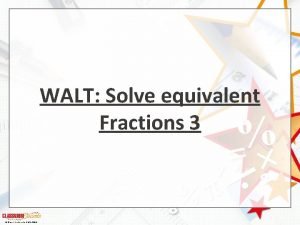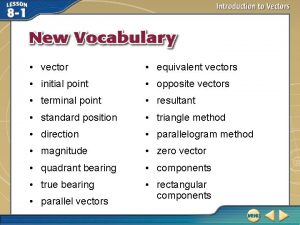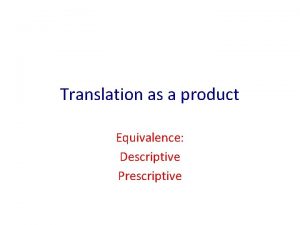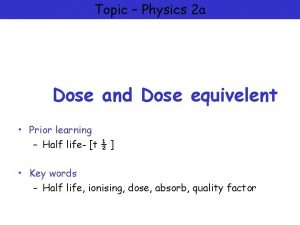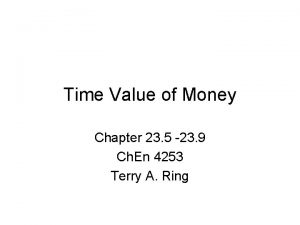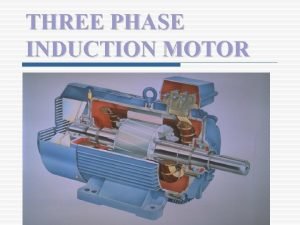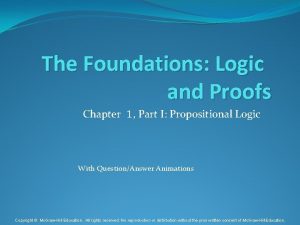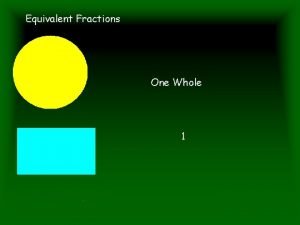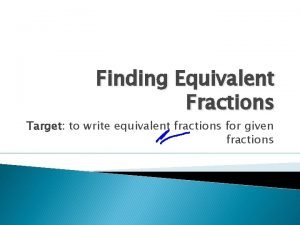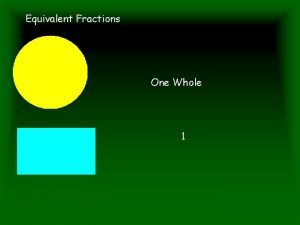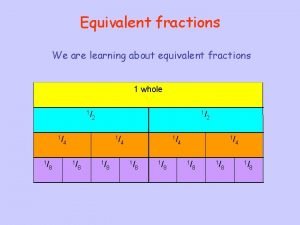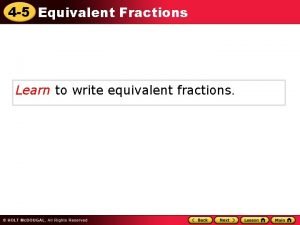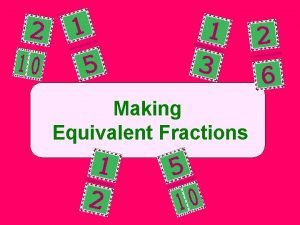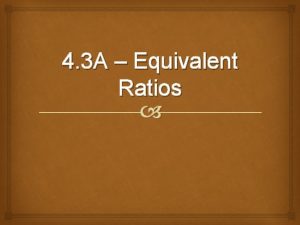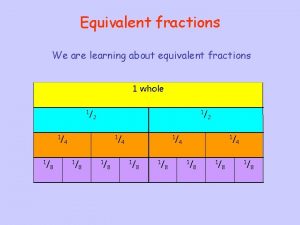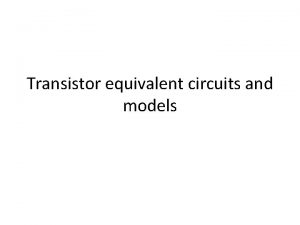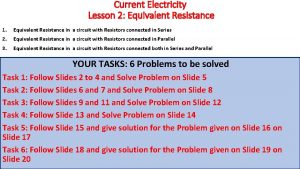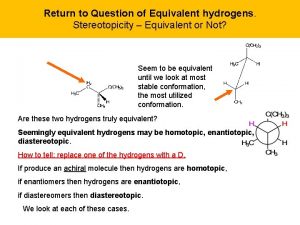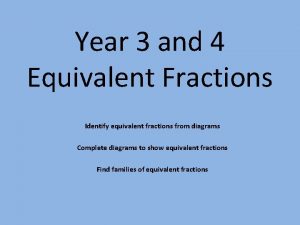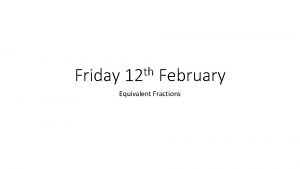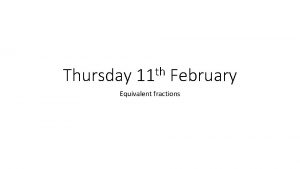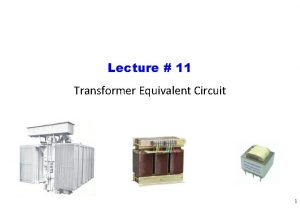4 7 AN EQUIVALENT SYSTEM APPLICATIONS What is



















- Slides: 19

4. 7 AN EQUIVALENT SYSTEM

APPLICATIONS What is the resultant effect on the person’s hand when the force is applied in four different ways ?

APPLICATIONS (continued) Several forces and a couple moment are acting on this vertical section of an I-beam. | | ? ? Can you replace them with just one force and one couple moment at point O that will have the same external effect? If yes, how will you do that?

AN EQUIVALENT SYSTEM = When a number of forces and couple moments are acting on a body, it is easier to understand their overall effect on the body if they are combined into a single force and couple moment having the same external effect The two force and couple systems are called equivalent systems since they have the same external effect on the body.

MOVING A FORCE ON ITS LINE OF ACTION Moving a force from A to O, when both points are on the vectors’ line of action, does not change the external effect. Hence, a force vector is called a sliding vector. (But the internal effect of the force on the body does depend on where the force is applied).

MOVING A FORCE OFF OF ITS LINE OF ACTION Moving a force from point A to O (as shown above) requires creating an additional couple moment. Since this new couple moment is a “free” vector, it can be applied at any point P on the body.

4. 8 RESULTANTS OF A FORCE AND COUPLE SYSTEM When several forces and couple moments act on a body, you can move each force and its associated couple moment to a common point O. Now you can add all the forces and couple moments together and find one resultant force-couple moment pair.

RESULTANT OF A FORCE AND COUPLE SYSTEM (continued) If the force system lies in the x-y plane (the 2 -D case), then the reduced equivalent system can be obtained using the following three scalar equations.

4. 9 FURTHER REDUCTION OF A FORCE AND COUPLE SYSTEM = = If FR and MRO are perpendicular to each other, then the system can be further reduced to a single force, FR , by simply moving FR from O to P. In three special cases, concurrent, coplanar, and parallel systems of forces, the system can always be reduced to a single force.


EXAMPLE #1 Given: A 2 -D force and couple system as shown. Find: The equivalent resultant force and couple moment acting at A and then the equivalent single force location along the beam AB. Plan: 1) Sum all the x and y components of the forces to find FRA. 2) Find and sum all the moments resulting from moving each force to A. 3) Shift the FRA to a distance d such that d = MRA/FRy

EXAMPLE #1 (continued) + FRx = 25 + 35 sin 30° = 42. 5 lb FR + FRy = 20 + 35 cos 30° = 50. 31 lb + MRA = 35 cos 30° (2) + 20(6) – 25(3) = 105. 6 lb·ft FR = ( 42. 52 + 50. 312 )1/2 = 65. 9 lb = tan-1 ( 50. 31/42. 5) = 49. 8 ° The equivalent single force FR can be located on the beam AB at a distance d measured from A. d = MRA/FRy = 105. 6/50. 31 = 2. 10 ft.

EXAMPLE #2 o Given: The building slab has four columns. F 1 and F 2 = 0. Find: Plan: 1) Find FRO = Fi = FRzo k The equivalent resultant force and couple moment at the origin O. Also find the location (x, y) of the single equivalent resultant force. 2) Find MRO = (ri Fi) = MRx. O i + MRy. O j 3) The location of the single equivalent resultant force is given as x = -MRy. O/FRz. O and y = MRx. O/FRz. O

EXAMPLE #2 (continued) o FRO = {-50 k – 20 k} = {-70 k} k. N MRO = (10 i) (-20 k) + (4 i + 3 j)x(-50 k) = {200 j + 200 j – 150 i} k. N·m = {-150 i + 400 j } k. N·m The location of the single equivalent resultant force is given as, x = -MRyo/FRzo = -400/(-70) = 5. 71 m y = MRxo/FRzo = (-150)/(-70) = 2. 14 m

GROUP PROBLEM SOLVING Given: A 2 -D force and couple system as shown. Find: The equivalent resultant force and couple moment acting at A. Plan: 1) Sum all the x and y components of the forces to find FRA. 2) Find and sum all the moments resulting from moving each force to A and add them to the 500 lb - ft free moment to find the resultant MRA.

GROUP PROBLEM SOLVING (continued) Summing the force components: + Fx = (4/5) 150 lb + 50 lb sin 30° = 145 lb + Fy = (3/5) 150 lb + 50 lb cos 30° = 133. 3 lb Now find the magnitude and direction of the resultant. FRA = ( 145 2 + 133. 3 2 )1/2 = 197 lb and = tan-1 ( 133. 3/145) = 42. 6 ° + MRA = { (4/5)(150)(2) – 50 cos 30° (3) + 50 sin 30° (6) + 500 } = 760 lb·ft

GROUP PROBLEM SOLVING (continued) Given: Handle forces F 1 and F 2 are applied to the electric drill. Find: An equivalent resultant force and couple moment at point O. Plan: a) Find FRO = Fi Where, b) Find MRO = MC + ( ri Fi ) Fi are the individual forces in Cartesian vector notation (CVN). MC are any free couple moments in CVN (none in this example). ri are the position vectors from the point O to any point on the line of action of Fi.


SOLUTION F 1 = {6 i – 3 j – 10 k} N F 2 = {0 i + 2 j – 4 k} N FRO = {6 i – 1 j – 14 k} N r 1 = {0. 15 i + 0. 3 k} m r 2 = {-0. 25 j + 0. 3 k} m MRO = r 1 F 1 + r 2 F 2 MRO = { } N·m = {0. 9 i + 3. 3 j – 0. 45 k + 0. 4 i + 0 j + 0 k} N·m = {1. 3 i + 3. 3 j – 0. 45 k} N·m
 Equivalent force couple system
Equivalent force couple system Force system in mechanics
Force system in mechanics Equivalent system
Equivalent system System applications and products in data processing
System applications and products in data processing Earth closed system
Earth closed system Digestive system circulatory system and respiratory system
Digestive system circulatory system and respiratory system Bond equivalent yield
Bond equivalent yield Wrat 4 grade equivalent table
Wrat 4 grade equivalent table 2/5 equivalent fractions
2/5 equivalent fractions Equivalent vectors
Equivalent vectors Equivalent ratio tables
Equivalent ratio tables Descriptive equivalent translation
Descriptive equivalent translation Tramslator
Tramslator Schema equivalent transistor
Schema equivalent transistor Equivalent dose is measured in
Equivalent dose is measured in Equivalent annuity formula
Equivalent annuity formula Introduction of induction motor
Introduction of induction motor Degree of financial leverage formula
Degree of financial leverage formula Must modal feli
Must modal feli Equivalent disjunctive form example
Equivalent disjunctive form example


